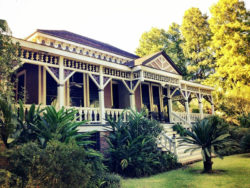Poplar Grove Plantation
The Poplar Grove Plantation house was originally built for the 1884 World's Industrial and Cotton Centennial Exposition in New Orleans before being transported on a barge to Port Allen.

Courtesy of Wikimedia Commons
Poplar Grove Plantation. Lbuck8182
The colorful and elaborately ornamented house at Poplar Grove plantation, located north of Port Allen in West Baton Rouge Parish, originated as the Banker’s Pavilion for the World’s Industrial and Cotton Centennial Exposition of 1884, held in New Orleans. It was designed by the noted New Orleans architect Thomas Sully. A reviewer for the New Orleans Daily Picayune deemed the pavilion “one of the handsomest structures on the Exhibition Grounds.” In 1886 sugar planter Joseph L. Harris purchased the pavilion and had it transported by barge up the Mississippi River to his plantation.
Fortunately, the river was unusually high that year, making the task of moving the building over the levee much easier. The house was then converted into a home for Harris’s plantation manager, Horace Wilkinson, and his wife, Julia. The Wilkinsons purchased the property in 1903, and their descendants still occupy the house.
The interior was given a central hall with two rooms on each side, four fireplaces were installed, and a rear wing was added. Sully adorned the front and side galleries with fashionable machine-made wood trim that included gallery brackets shaped as Chinese dragons, grilles of Eastlake spindles, and an elaborate modillion cornice skirting a hipped roof that rises above the gallery roof. A cupola and spire were removed before the building was taken upriver. Upper window sashes have stained glass in checkered patterns. During an early twentieth-century remodeling, a rear cottage built in the 1850s was extended and joined to the house.
A levee setback of the mid-1920s brought the river much closer to the house, and the plantation’s grove of poplar trees was removed. A short distance downriver on the west side of the road are a few disintegrating slave cabins, a mere handful of the approximately fifty that still housed tenants in the mid-1960s. The Wilkinson family continued to operate the plantation’s sugar business until 1982; some of the land is still used for sugar cultivation. Poplar Grove is open for tours by appointment.
